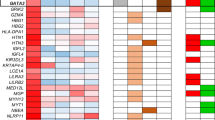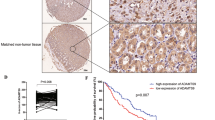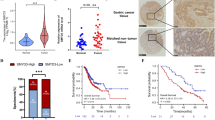Abstract
AKAP12/Gravin, one of the A-kinase anchoring proteins (AKAPs), functions as a kinase scaffold protein and as a dynamic regulator of the β2-adrenergic receptor complex. However, the biological role of AKAP12 in cancer development is not well understood. The AKAP12 gene encodes two major isoforms of 305 and 287 kDa (designated AKAP12A and AKAP12B, respectively, in this report). We found that these two isoforms are independently expressed and that they are probably under the control of two different promoters. Moreover, both isoforms were absent from the majority of human gastric cancer cells. The results from methylation-specific PCR (MSP) and bisulfite sequencing revealed that the 5′ CpG islands of both AKAP12A and AKAP12B are frequently hypermethylated in gastric cancer cells. Treatment with DNA methyltransferase inhibitor and/or histone deacetylase inhibitor efficiently restored the expression of AKAP12 isoforms, confirming that DNA methylation is directly involved in the transcriptional silencing of AKAP12 in gastric cancer cells. Hypermethylation of AKAP12A CpG island was also detected in 56% (10 of 18) of primary gastric tumors. The restoration of AKAP12A in AKAP12-nonexpressing cells reduced colony formation and induced apoptotic cell death. In conclusion, our results suggest that AKAP12A may function as an important negative regulator of the survival pathway in human gastric cancer.
This is a preview of subscription content, access via your institution
Access options
Subscribe to this journal
Receive 50 print issues and online access
$259.00 per year
only $5.18 per issue
Buy this article
- Purchase on Springer Link
- Instant access to full article PDF
Prices may be subject to local taxes which are calculated during checkout







Similar content being viewed by others
References
Burgers WA, Fuks F and Kouzarides T . (2002). Trends Genet., 18, 275–277.
Cameron EE, Bachman KE, Myohanen S, Herman JG and Baylin SB . (1999). Nat. Genet., 21, 103–107.
Conway KE, McConnell BB, Bowring CE, Donald CD, Warren ST and Vertino PM . (2000). Cancer Res., 60, 6236–6242.
Dammann R, Li C, Yoon JH, Chin PL, Bates S and Pfeifer GP . (2000). Nat. Genet., 25, 315–319.
Dammann R, Takahashi T and Pfeifer GP . (2001). Oncogene, 20, 3563–3567.
Dell'Acqua ML and Scott JD . (1997). J. Biol. Chem., 272, 12881–12884.
Diviani D and Scott JD . (2001). J. Cell Sci., 114, 1431–1437.
Du Y, Carling T, Fang W, Piao Z, Sheu JC and Huang S . (2001). Cancer Res., 61, 8094–8099.
Esteller M . (2002). Oncogene, 21, 5427–5440.
Feliciello A, Gottesman ME and Avvedimento EV . (2001). J. Mol. Biol., 308, 99–114.
Gelman IH . (2002). Front. Biosci., 7, d1782–1797.
Gordon T, Grove B, Loftus JC, O'Toole T, McMillan R, Lindstrom J and Ginsberg MH . (1992). J. Clin. Invest., 90, 992–999.
Issa JP, Ahuja N, Toyota M, Bronner MP and Brentnall TA . (2001). Cancer Res., 61, 3573–3577.
Jones PA and Baylin SB . (2002). Nat. Rev. Genet., 3, 415–428.
Jones PA and Laird PW . (1999). Nat. Genet., 21, 163–167.
Jones PA and Taylor SM . (1980). Cell, 20, 85–93.
Jong HS, Lee HS, Kim TY, Im YH, Park JW, Kim NK and Bang YJ . (2002). Biochem. Biophys. Res. Commun., 292, 383–389.
Kang GH, Shim YH, Jung HY, Kim WH, Ro JY and Rhyu MG . (2001). Cancer Res., 61, 2847–2851.
Kang SH, Bang YJ, Jong HS, Seo JY, Kim NK and Kim SJ . (1999). Br. J. Cancer, 80, 1144–1149.
Kim SG, Kim SN, Jong HS, Kim NK, Hong SH, Kim SJ and Bang YJ . (2001). Oncogene, 20, 1254–1265.
Kim TY, Jong HS, Song SH, Dimtchev A, Jeong SJ, Lee JW, Kim TY, Kim NK, Jung M and Bang YJ . (2003). Oncogene, 22, 3943–3951.
Lee SW, Kim WJ, Choi YK, Song HS, Son MJ, Gelman IH, Kim YJ and Kim KW . (2003). Nat. Med., 9, 900–906.
Li B, Goyal J, Dhar S, Dimri G, Evron E, Sukumar S, Wazer DE and Band V . (2001). Cancer Res., 61, 8014–8021.
Lin F, Wang H and Malbon CC . (2000a). J. Biol. Chem., 275, 19025–19034.
Lin X and Gelman IH . (1997). Cancer Res., 57, 2304–2312.
Lin X and Gelman IH . (2002). Biochem. Biophys. Res. Commun., 290, 1368–1375.
Lin X, Nelson P and Gelman IH . (2000b). Mol. Cell. Biol., 20, 7259–7272.
Lin X, Nelson PJ, Frankfort B, Tombler E, Johnson R and Gelman IH . (1995). Mol. Cell. Biol., 15, 2754–2762.
Liu L, Shao G, Steele-Perkins G and Huang S . (1997). J. Biol. Chem., 272, 2984–2991.
Millikin D, Meese E, Vogelstein B, Witkowski C and Trent J . (1991). Cancer Res., 51, 5449–5453.
Nauert JB, Klauck TM, Langeberg LK and Scott JD . (1997). Curr. Biol., 7, 52–62.
Park JH, Kim TY, Jong HS, Kim TY, Chun YS, Park JW, Lee CT, Jung HC, Kim NK and Bang YJ . (2003). Clin. Cancer res., 9, 433–440.
Sato N, Kokame K, Shimokado K, Kato H and Miyata T . (1998). J. Biochem., 123, 1119–1126.
Shih M, Lin F, Scott JD, Wang HY and Malbon CC . (1999). J. Biol. Chem., 274, 1588–1595.
Song SH, Jong HS, Choi HH, Inoue H, Tanabe T, Kim NK and Bang YJ . (2001). Cancer Res., 61, 4628–4635.
Song SH, Jong HS, Choi HH, Kang SH, Ryu MH, Kim NK, Kim WH and Bang YJ . (2000). Int. J. Cancer, 87, 236–240.
Tibiletti MG, Sessa F, Bernasconi B, Cerutti R, Broggi B, Furlan D, Acquati F, Bianchi M, Russo A, Capella C and Taramelli R . (2000). Clin. Cancer Res., 6, 1422–1431.
Toyooka KO, Toyooka S, Virmani AK, Sathyanarayana UG, Euhus DM, Gilcrease M, Minna JD and Gazdar AF . (2001). Cancer Res., 61, 4556–4560.
Xia W, Unger P, Miller L, Nelson J and Gelman IH . (2001). Cancer Res., 61, 5644–5651.
Xiong Z and Laird PW . (1997). Nucleic Acids Res., 25, 2532–2534.
Acknowledgements
We are thankful to Dr JD Scott for his kind gifts of the AKAP12/Gravin construct and antibody, and to all members of our laboratory, particularly to Jin-Ah Park, for technical assistance and critical discussions. We also thank Jae-Jung Lee for helpful advice with the preparation of the adenoviral constructs. This work was supported in part by grants from the Ministry of Science & Technology of Korea through the National Research Laboratory Program for Cancer Epigenetics and by 2002 BK21 Project for Medicine, Dentistry, and Pharmacy.
Author information
Authors and Affiliations
Corresponding authors
Rights and permissions
About this article
Cite this article
Choi, MC., Jong, HS., Kim, T. et al. AKAP12/Gravin is inactivated by epigenetic mechanism in human gastric carcinoma and shows growth suppressor activity. Oncogene 23, 7095–7103 (2004). https://doi.org/10.1038/sj.onc.1207932
Received:
Revised:
Accepted:
Published:
Issue Date:
DOI: https://doi.org/10.1038/sj.onc.1207932
Keywords
This article is cited by
-
Upregulated CD58 is associated with clinicopathological characteristics and poor prognosis of patients with pancreatic ductal adenocarcinoma
Cancer Cell International (2021)
-
LINC00163 inhibits the invasion and metastasis of gastric cancer cells as a ceRNA by sponging miR-183 to regulate the expression of AKAP12
International Journal of Clinical Oncology (2020)
-
Kinome and phosphoproteome of high-grade meningiomas reveal AKAP12 as a central regulator of aggressiveness and its possible role in progression
Scientific Reports (2018)
-
Scaffolding during the cell cycle by A-kinase anchoring proteins
Pflügers Archiv - European Journal of Physiology (2015)
-
Gravin gene expression in acute myeloid leukemia
Medical Oncology (2013)



